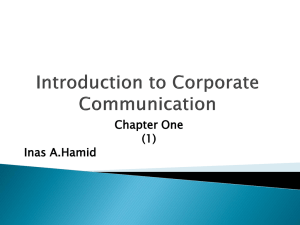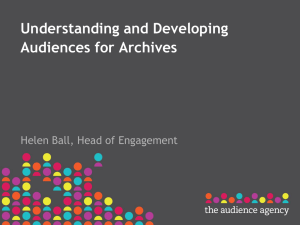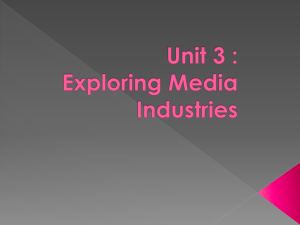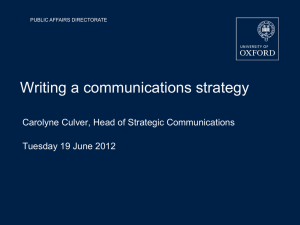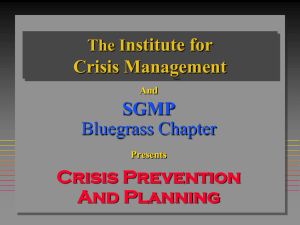Communications & Marketing at London`s Global University
advertisement
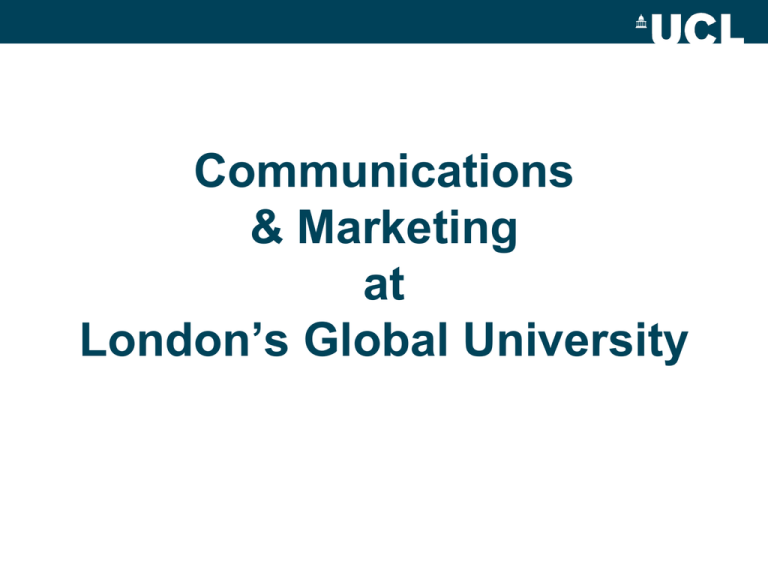
Communications & Marketing at London’s Global University Communications & Marketing Mission To maintain & develop the reputation & profile of London’s Global University as a world-leading organisation and as an aspirational choice as a study destination Objectives: – to communicate UCL’s corporate vision and strategic direction to key internal and external audiences – to increase UCL’s positive public profile as a world-leading university – to increase the number and quality of applicants to UCL degree programmes Why reputation matters • Influences our ability to attract and retain the best staff • Directly contributes to our ability to recruit the best students – particularly internationally • Reputation affects funding decisions – to support research, teaching and institutional development • It influences our ability to engage with the best collaborations, partnerships, knowledge transfer activity, and public engagement Embedding A Strategic Approach CORPORATE STRATEGY Plan communications & marketing activities to support institutional objectives AUDIENCES Identify and understand key audiences MESSAGE Target messages to specific audiences CHANNELS Use appropriate vehicles to maximise influencing opportunities Corporate Strategy CORPORATE STRATEGY AUDIENCES MESSAGE CHANNELS • Communications & Marketing supports institutional priorities: – – – – – – – White Paper Research strategy Teaching and Learning strategy International strategy Enterprise strategy Partnerships (including Crick Institute, UCL Partners) Estates strategy, Fundraising, Public engagement Corporate Strategy CORPORATE STRATEGY AUDIENCES MESSAGE CHANNELS • Communications & Marketing supports academic faculties and departments: – developing a co-ordinated approach across the institution, with Faculty Comms Managers and through the UCL Communications Network – developing tailored international recruitment plans – development of effective student recruitment marketing materials – developing effective communications strategies Audiences CORPORATE STRATEGY AUDIENCES MESSAGE CHANNELS • Understanding our audiences and their needs – Market research – Mapping across UCL • Key priority groups – STUDENTS: prospective (+ influencers), current, alumni – STAFF: current & prospective – OPINION FORMERS / FUNDERS: HE sector; Government; Business, International, London Messages CORPORATE STRATEGY AUDIENCES MESSAGE • Scale / diversity is a challenge and an opportunity • Consistent top level messaging for key audiences • Themes – – – – – – – Excellence – breakthroughs, citations, league tables Global initiatives London / Community Innovation in teaching Graduate employability / Global Citizens Interdisciplinarity / Grand challenges Enterprise CHANNELS Channels CORPORATE STRATEGY AUDIENCES MESSAGE • Face to face – recruitment – Events – public & networking • Online / multimedia – audience focused, innovation – audio visual, social media • Publications – targeted, branded • Media – – reputation management /reactive – planning, prioritising, expert comment CHANNELS Planning & Delivery • UCL Communications network • Communications grid – planning, sequencing • Key message framework • Corporate Identity guidelines & styleguide • Evaluation/ monitoring – communications scorecard • Success measures – Key metrics across range of channels – Stakeholder perception research Media • Reputation management as well as proactive communications • Planning & prioritisation • Relationship building – internally & externally • Targeting key media - & understanding social media • Supporting fundraising: – focus on the story – people & outcomes, not just money • Evaluation/ monitoring Branding your brand = your reputation your brand = what people say about you your corporate identity = a visual shorthand for everything you do • Maintaining A STRONG CONSISTENT brand reinforces institutional strengths • Be RECOGNISED AND DIFFERENTIATED in a competitive market • Harnessing the strengths of ONE INSITUTION for our wide range of audiences Branding – delivery • Institutional buy-in to strategic approach • Clarity on boundaries, sub-brands & partnerships • Corporate identity guidelines: – COLOUR, TYPEFACE, IMAGERY – GRAPHIC ELEMENTS, TONE OF VOICE – LOGO / banner device • Using networks for implementation – Web – Design/ print – Legal / business • Review and refresh Getting started CORPORATE STRATEGY AUDIENCES MESSAGE CHANNELS • Agree clear, achievable targets with the institution's leadership aligned with strategic goals • Identify key audiences, understand their communications needs • Develop high level key messages • Assess the most effective channels • Identify priority media targets and nurture those relationships • Establish a planning structure for identifying stories • Develop effective evaluation of activity • Build teams incrementally on the basis of evidence of positive outcomes

